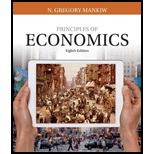
Relation between money supply and aggregate demand .
Answer to Problem 1CQQ
Option ‘b’ is correct.
Explanation of Solution
Option (b):
By the theory of liquidity preference, an increase in the money supply shifts the money supply curve to the right causing the equilibrium interest rate to decrease. This stimulates consumption and investment, thereby expanding aggregate demand. Thus, option ‘b’ is correct.
Option (a):
Increase in money supply shifts the money supply curve to the right, which lowers the interest rate. Thus, option ‘a’ is incorrect.
Option (c):
By the theory of liquidity preference, a decrease in money supply shifts the money supply curve to the left causing the equilibrium interest rate to increase. This reduces consumption and investment, thereby contracting aggregate demand. Thus, option ‘c’ is incorrect.
Option (d):
Decrease in money supply shifts the money supply curve to the left, which increases the interest rate. Thus, option ‘d’ is incorrect.
Concept introduction:
Aggregate demand (AD): Aggregate demand refers to the total value of the goods and services that are demanded at a particular price in a given period.
Money supply: Money supply refers to the total amount of monetary assets circulating in an economy during a particular period.
Want to see more full solutions like this?
Chapter 34 Solutions
Principles of Economics (MindTap Course List)
- Which of the following is correct? The demand for money *a. increases as real GDP increases.b. increases when the interest rate increases.c. depends on the quantity of money.d. decreases as the price level increasesarrow_forwardOnly typed answer and please don't use chatgpt _________________will cause the money demand curve to shift to the left and the nominal interest rate to decrease. a. A decrease in price b. An increase in money supply c. A decrease in money supply d. An increase in pricearrow_forwardThe Fed wants to decrease the money supply when the economy is booming and inflationary pressures ________ in the economy.arrow_forward
- a) Explain what happens to Money Demand when each of the following occurs: i, incomes rise; ii. the interest rate rises. b. Use the money market to explain why the aggregate demand curve slopes downward.arrow_forwardIn an economy where the central bank implements negative interest rates as a monetary policy tool, what is the most likely short-term impact on consumer savings behavior and bank profitability? A. An increase in consumer savings as people seek to safeguard their money and a rise in bank profitability due to increased lending. B. A decrease in consumer savings as the incentive to save diminishes and a decrease in bank profitability due to lower interest margins. C. No significant change in consumer savings behavior but an improvement in bank profitability due to lower borrowing costs. D. A shift in consumer investment towards riskier assets and challenges in bank profitability due to compressed interest margins. Please don't use chatgpt it is giving wrong answer and please provide valuable answerarrow_forwardIf an economy is operating at full employment and there is a substantial increase in the money supply, which of the following is most likely to happen? A. Inflation increases B. Interest rates increase C. Real GDP increases D. Unemployment increasesarrow_forward
- Read the event The Federal Reserve raises reserve requirements. What would likely result from this event? A. An economy would see a slight decrease in aggregate demand. B. Interest rates on loans decline. C. Consumer demand would increase thus increasing prices. D. Inflation would reach levels that are acceptable for full employment.arrow_forwardIf the central bank wa nts to expand aggregate demand, it ca n ___ the money supply, whichwould the interest rate.a. increase, increaseb. increase, decreasec. decrease, increased. decrease, decreasearrow_forwardWhen the Fed sells government securities (bonds), the money supply will ______ . a. first increase and then decrease b. first decrease and then increase c. increase d. decreasearrow_forward
- if the fed raise the reserve requirment on deposit from 15% to 20%, what would happen to the money supply? a. it would increase b. it would remain unchanged c, it depends on the value of interest rates d, it would decreasearrow_forwardIf the Fed increases the money supply, in the short run interest rates will ________ and investment spending will __________. Rise; go down Decline; go down Rise; increase Decline; increasearrow_forwardWhat does the interest rate effect say? a. Interest rates causes inflation to go down b. Interest rates causes aggregate demand to have an upward slope c. as prices go up, interest rates will control inflation and prevent it from increasing d. when prices for outputs rise, the same purchases will take more money or credit to accomplisharrow_forward

 Principles of Economics (12th Edition)EconomicsISBN:9780134078779Author:Karl E. Case, Ray C. Fair, Sharon E. OsterPublisher:PEARSON
Principles of Economics (12th Edition)EconomicsISBN:9780134078779Author:Karl E. Case, Ray C. Fair, Sharon E. OsterPublisher:PEARSON Engineering Economy (17th Edition)EconomicsISBN:9780134870069Author:William G. Sullivan, Elin M. Wicks, C. Patrick KoellingPublisher:PEARSON
Engineering Economy (17th Edition)EconomicsISBN:9780134870069Author:William G. Sullivan, Elin M. Wicks, C. Patrick KoellingPublisher:PEARSON Principles of Economics (MindTap Course List)EconomicsISBN:9781305585126Author:N. Gregory MankiwPublisher:Cengage Learning
Principles of Economics (MindTap Course List)EconomicsISBN:9781305585126Author:N. Gregory MankiwPublisher:Cengage Learning Managerial Economics: A Problem Solving ApproachEconomicsISBN:9781337106665Author:Luke M. Froeb, Brian T. McCann, Michael R. Ward, Mike ShorPublisher:Cengage Learning
Managerial Economics: A Problem Solving ApproachEconomicsISBN:9781337106665Author:Luke M. Froeb, Brian T. McCann, Michael R. Ward, Mike ShorPublisher:Cengage Learning Managerial Economics & Business Strategy (Mcgraw-...EconomicsISBN:9781259290619Author:Michael Baye, Jeff PrincePublisher:McGraw-Hill Education
Managerial Economics & Business Strategy (Mcgraw-...EconomicsISBN:9781259290619Author:Michael Baye, Jeff PrincePublisher:McGraw-Hill Education





